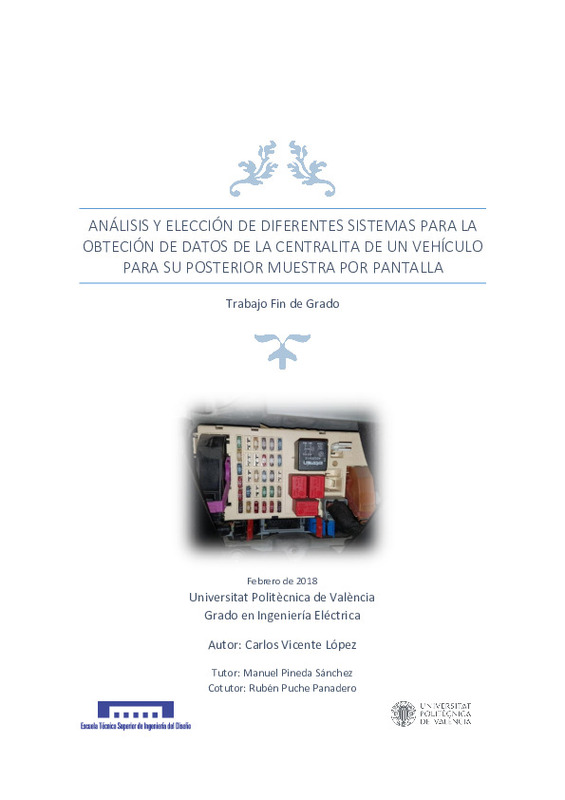|
Resumen:
|
[ES] La finalidad de este trabajo fin de grado es la de realizar un estudio con tal de determinar el mejor sistema para obtener datos de diagnosis de la centralita de un vehículo, en concreto un Fiat Stilo 1.9 JTD de 2002, ...[+]
[ES] La finalidad de este trabajo fin de grado es la de realizar un estudio con tal de determinar el mejor sistema para obtener datos de diagnosis de la centralita de un vehículo, en concreto un Fiat Stilo 1.9 JTD de 2002, para que posteriormente se muestren los datos obtenidos mediante una interfaz gráfica.
Para realizar esta tarea, primero trataremos de conocer el método de comunicación que emplea el vehículo para comunicarse con todos sus controladores.
Habiendo analizado la red del vehículo y sabiendo que este se comunica mediante una red tipo CAN denominada red Mini F.L.Ore.N.C.E, escogeremos una serie de alternativas para compararlas y determinar cuál de ellas es la que mejor se adapta a este proyecto.
Durante este estudio nos decantamos por la primera alternativa seleccionada, el autómata, debido a la alta seguridad tanto de su software como de su hardware. A pesar de haber elegido está alternativa, estudiaremos también el Arduino y la Raspberry como posibles alternativas, que aunque carezcan de tanta seguridad como el autómata, son igual de viables y dignas de estudio.
Habiendo analizado las tres alternativas, realizamos una tabla donde se tendrán en cuenta distintos factores relevantes de cada alternativa. Con esto pretendemos hacer más fácil la comparación y también ver los puntos fuertes y débiles de cada alternativa.
Después de esta comparativa, demostramos fehacientemente que el autómata es la mejor alternativa, destacando por encima de todo la seguridad que este nos aporta, ya que minimiza cualquier posible fallo en el sistema o en la transmisión de datos.
Finalmente desarrollaremos una simulación con un autómata del Departamento de Ingeniería Eléctrica de nuestra universidad, con tal de demostrar las más que sobradas capacidades de esta alternativa, así como el sin fin de posibilidades que el autómata nos permite realizar.
[-]
[EN] The purpose of this final degree project is to carry out a study in order to determine the best system to obtain diagnosis data from a vehicle's control unit, specifically a Fiat Stilo 1.9 JTD from 2002, for showing ...[+]
[EN] The purpose of this final degree project is to carry out a study in order to determine the best system to obtain diagnosis data from a vehicle's control unit, specifically a Fiat Stilo 1.9 JTD from 2002, for showing the data obtained later through a graphical interface.
To perform this task, we will first try to know the method of communication used by the vehicle to communicate with all its controllers.
Having analyzed the vehicle network and knowing that it is communicating through a CAN type network called the Mini F.L.Ore.N.C.E network, we will choose a series of alternatives to compare them and determine which one is best suited to this project.
During this study we opted for the first alternative selected, the automaton, due to the high security of its software and its hardware. Despite having chosen this alternative, we will also study the Arduino and the Raspberry as possible alternatives, that although they lack as much security as the automaton, are equally viable and worthy of study.
Having analyzed the three alternatives, we made a table where different relevant factors of each alternative will be taken into account. With this we aim to make the comparison easier and also see the strengths and weaknesses of each alternative.
After this comparison, we demonstrate conclusively that the automaton is the best alternative, highlighting above all the security that this gives us, because it minimizes any possible failure in the system or in the transmission of data.
Finally we will develop a simulation with an automaton of the Electrical Engineering Department of our university, in order to demonstrate the more than enough capacities of this alternative, as well as the endless possibilities that the automaton allows us to perform.
[-]
|





![MS Powerpoint file [PP]](/themes/UPV/images/mspowerpoint.png)
![Imagen archive [IMAGE]](/themes/UPV/images/camera.png)


